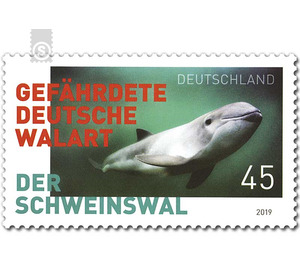The Porpoise - Endangered German Whale Species, self-adhesive - Germany / Federal Republic of Germany 2019 - 45 Euro Cent
Theme: Animals
| Country | Germany / Federal Republic of Germany |
| Issue Date | 2019 |
| Face Value | 45.00 |
| Color | green red |
| Stamp Type | Commemorative |
| Item Type | Stamp |
| SID | 462944 |
| Dimensions | 39.00 x 22.00 |
| In 41 Wishlists | |
The porpoise (Phocoena phocoena) is the only species of whale that lives in the waters off the German coast. Over the past 50 years, its stocks have fallen sharply. Porpoises require our special attention and protection. They are protected in all European countries and are listed in the Washington Convention. They face little natural predators, while many man-made dangers lurk: noise from marine engines and ammunition, death as by-catch in the fishing nets and entry of heavy metals such as mercury, lead or cadmium, which are deposited in the muscles and the liver. Particularly endangered are the animals in the Baltic Sea. Its population is estimated at 800 to 2,000 in the western part and 100 to 600 in the eastern and central parts. If they do not fall prey to any of the threats, they can reach a maximum age of 20 years, with most animals not older than eight to ten years. Self-adhesive, smaller than the gummed version, set of 10.


